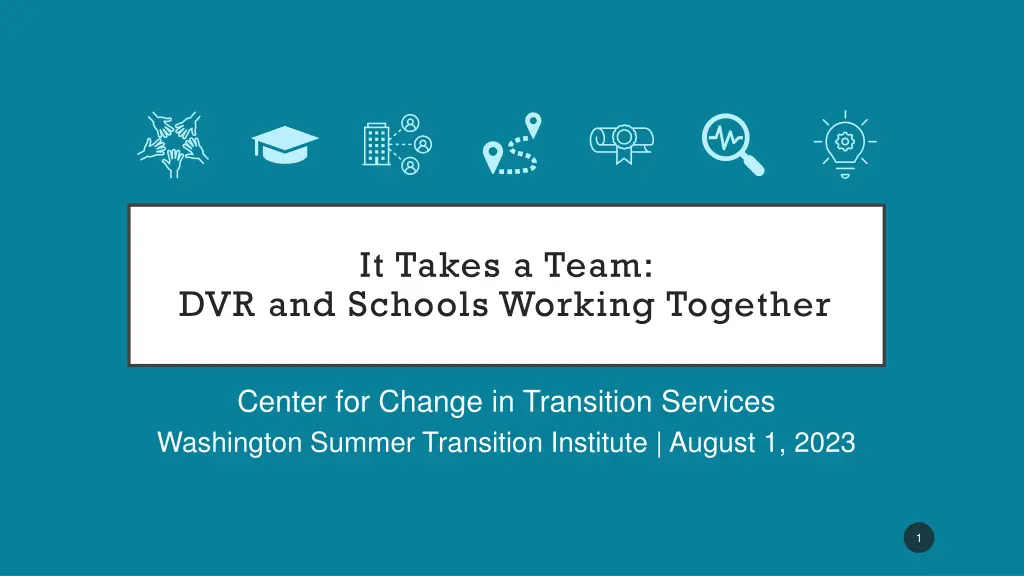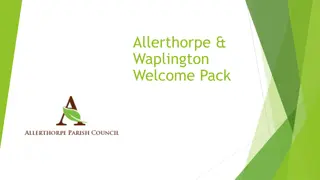
Working Together for Transition Success
Empowering educators to enhance transition services for youth with disabilities through collaboration, research, and training. Explore the purpose of high school, post-school outcomes, and life after graduation. Join the discussion at the Washington Summer Transition Institute.
Download Presentation

Please find below an Image/Link to download the presentation.
The content on the website is provided AS IS for your information and personal use only. It may not be sold, licensed, or shared on other websites without obtaining consent from the author. If you encounter any issues during the download, it is possible that the publisher has removed the file from their server.
You are allowed to download the files provided on this website for personal or commercial use, subject to the condition that they are used lawfully. All files are the property of their respective owners.
The content on the website is provided AS IS for your information and personal use only. It may not be sold, licensed, or shared on other websites without obtaining consent from the author.
E N D
Presentation Transcript
It Takes a Team: DVR and Schools Working Together Center for Change in Transition Services Washington Summer Transition Institute | August 1, 2023 1
Welcome Purpose of High School You Know What You Know Post-School Outcomes Learning From Our Students DVR and Schools Working Together Suggestions and Recommendations Reflection and Wrap-up 2
Center for Change in Transition Services Empowering educators to improve transition services for youth with disabilities through partnerships, research, and training Funded by the Office of Superintendent of Public Instruction Located at Seattle University 3
What is the Purpose of High School? Take 5 minutes and discuss at your table your thoughts on the purpose of high school. Think about what your life would look like after high school, and the people who helped you get there. After 12 or more years spent in schools, what specific skills, experiences, and knowledge should students take with them? 5
Timer 6
Feedback 7
All Roads Lead to Graduation Pressure is on graduation Culmination of high school is graduation I m the class of And then: The requirement for transition services was added to the Individuals with Disabilities Education Act (IDEA) in 1990. Congress included this mandate in the IDEA to ensure that students with disabilities would be prepared for post-school life. 9
Life After High School: All Roads Lead to Employment Postsecondary education Training Independent living skills Community access Resources and support 10
1-10 years out Injured and couldn t meet physical requirements of the job Still couldn t read or write well Didn t understand disability but knew that school wasn t for them Didn t know how to ask for accommodations/advocate for needs Didn t have any idea about where to find support or resources 11
What are Post-School Outcomes? A snapshot of life one year after leaving high school. Former students, ages 16-21, with an IEP who left school by: Graduating with a diploma Aging out at age 21 Dropping out School districts call the former students between June 1 and November 1 the year following their exit. So much data, so much information. 13
Post-School Outcome Categories Any Engagement Higher Education Competitive Employment Other Education Other Employment No Engagement No Engagement Post-School Outcome Definitions available on the CCTS website 14
Post-School Outcomes, 2020-21 Washington state data tables Total number of 2020-21 leavers 7,938 Total number of respondents (Resp'ts) 6,261 Survey response rate 78.87% Higher Education Competitive Employment Other Education Other No Employment Engagement Resp ts 6,261 16.87% 30.75% 3.91% 22.74% 25.73% (CCTS 2023, Indicator B14 Post-School Outcome Report, Washington state, 2020-21) 15
Post-School Outcomes, 2020-21 Washington state graph Higher Education 16.87% Competitive Employment 30.75% Other Education 3.91% Other Employment 22.74% No Engagement 25.73% (CCTS 2023, Indicator B14 Post-School Outcome Report, Washington state, 2020-21) 16
Learning from Our Students Survey Follow-up Questions 17
Former Students Who Dropped Out Learning from the Stories Behind the Data: Why Students with Disabilities are Dropping out of High School in Washington state - Dr. Cynthia Gale, 2023 Health challenges Left school to work, often for financial issues Disability and disengagement 18
Former Students Who Attempted School or Work Health challenges, anxiety, depression Family issues Didn t fit the job so either quit or got fired Didn t ask for accommodations (how, who, what) 19
DVR and Schools Working Together 20
Workforce Innovation and Opportunity Act of 2014 (WIOA) Established a new emphasis on the provision of Vocational Rehabilitation services to students and youth with disabilities Expanded the population of students with disabilities who could receive services from VR, and the kinds of services that VR agencies may provide to youth and students with disabilities Requires VR agencies to provide or arrange for the provision of five required Pre-Employment Transition Services (Pre-ETS) to students and potentially eligible students with disabilities Also, requires State VR agencies to provide evidence of the extent to which Pre- ETS have been made available to all potentially eligible students with disabilities
Washington State Contexts 2021-2022 High School Enrollment- Students with Disabilities- WA Grade Level Student w/ IEP Students w/ 504 Combined 9th 10,756 4,913 15,669 10th 10,359 5,039 15,398 11th 9,828 5,230 18,491 12th 12,990 5,501 18,491 Total 9th -12th 43,933 20,683 64,616 Total 10th-12th 33,177 15,770 48,947
Continuum of Coordinated Transition Services Education, Employment, and Independent Living! School Based Transition Services Pre-Employment Transition Services Individualized VR Services Transition Services are design to be a results-oriented process that facilitates the movement from school to postsecondary
Comparing Activities IDEA TRANSITION SERVICES Instruction Related Services Community Experiences Development of Employment and other post-school adult living objectives If appropriate, acquisition of daily living skills and provision of a functional vocational evaluation WIOA PRE-ETS Job Exploration Self-Advocacy Work-Based Learning Workplace Readiness Training Postsecondary Education Counseling 24
What the PSO Data Tell Us About Agency Linkages When asked if they contacted an adult agency in the year after high school, nearly 20% of the 6,261 respondents answered yes . Agency Total Resp ts 392 (6%) 265 (4%) 141 (2%) 91 (1%) 108 (2%) 45 (<1%) 12 (<1%) 192 (2%) Division of Vocational Rehabilitation Developmental Disabilities Administration Disability Support Services - college Mental Health Provider WorkSource Job Corps WA State Department of Services for the Blind Other 25
Outcomes for Respondents who Contacted DVR Higher Education Competitive Employment Other Education Other No Employment Engagement Resp ts 392 11.73% 13.01% 8.42% 25.77% 41.07% 26
Suggestions and Recommendations 27
Student Needs: In High School Mentors Relevancy of high school classes to real world Interests and career exploration Information and advocacy skills to access services Understanding disability and rights 28
Student Needs: After High School Identifying strengths, preferences, interests and needs to identify work, training, or postsecondary education Finding and keeping employment Completing postsecondary education or training programs Knowing how to advocate and receive accommodations on the job or in postsecondary education/training Knowing how and where to find resources (e.g., shelter, health/emergency care) 29
What if? Every student with a disability leaves high school with contact information for a person/agency that provides services to adults with disabilities. Every IEP includes this information. 30
Building Partnerships Educators and DVR know each other Understand agency structures Understand each others jobs Responsibilities, case loads, hours Interagency Transition Networks 31
School Staff Meet DVR staff Regional Transition Consultants High school liaisons Regional administrators Share and Invite Share overview of transition services Share strengths and needs around transition services Invite DVR to meet students and families Invite DVR to present to classes (Job exploration, Self-advocacy) 32
DVR Staff Meet high school staff Special education teachers, staff High school counselor Principal, administrators Special education director Share Services Ideas for interests and job exploration Importance of and skills for self-advocacy Eligibility process 33
Mission Control Center (MCC) MCC is divided into flight control and ground-team workers 10% of time is controlling missions 75% is spent planning and organizing 15% devoted to their own training 35
Teamwork The ground team gathers data Flight control team analyzes data to make procedural decisions Team generates procedures Generic procedures in place for every launch Mission-specific procedures tailored to specific situations 36
Simfaults Every simulation has a simfault thrown into the mix. A simfault could be a malfunctioning piece of equipment or it could be a major disaster situation. The way the workers respond shows us how we need to prepare in case the real thing should ever happen." William Foster, MCC ground controller 37
Thank You 38
Contact and Connect with CCTS ccts@seattleu.edu www.seattleu.edu/ccts Subscribe to our newsletters 39
Creative Commons License Except where otherwise noted, content in this presentation is licensed under a Creative Commons Attribution 4.0 International license. All logos and trademarks are property of their respective owners. You may share and adapt this material, but you must give appropriate credit, provide a link to the license, and indicate if changes were made. 40






















